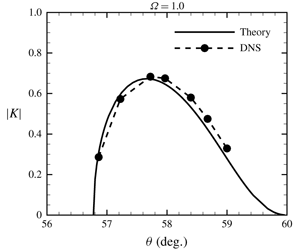Article contents
Generation of first Mack modes in supersonic boundary layers by slow acoustic waves interacting with streamwise isolated wall roughness
Published online by Cambridge University Press: 06 February 2020
Abstract

This paper investigates the receptivity of a supersonic boundary layer to slow acoustic waves whose characteristic frequency and wavelength are on the triple-deck scales, and the phase speed is thus asymptotically small. Acoustic waves on these scales are of special importance as they have the interesting property that a perturbation with a magnitude of  $O(\unicode[STIX]{x1D716}_{u})$ in the free stream generates much larger,
$O(\unicode[STIX]{x1D716}_{u})$ in the free stream generates much larger,  $O(\unicode[STIX]{x1D700}_{u}R^{1/8})$, velocity fluctuations inside the boundary layer, where
$O(\unicode[STIX]{x1D700}_{u}R^{1/8})$, velocity fluctuations inside the boundary layer, where  $R$ is the Reynolds number based on the distance to the leading edge. Their interaction with streamwise localized roughness elements, leading to stronger receptivity, is studied using triple-deck theory and direct numerical simulations (DNS). The receptivity coefficient, defined as the ratio of the streamwise-velocity amplitude of the instability mode excited to that of the incident free-stream acoustic wave, serves to characterize receptivity efficiency. Its dependence on the roughness width, the Reynolds number
$R$ is the Reynolds number based on the distance to the leading edge. Their interaction with streamwise localized roughness elements, leading to stronger receptivity, is studied using triple-deck theory and direct numerical simulations (DNS). The receptivity coefficient, defined as the ratio of the streamwise-velocity amplitude of the instability mode excited to that of the incident free-stream acoustic wave, serves to characterize receptivity efficiency. Its dependence on the roughness width, the Reynolds number  $R$, the free-stream Mach number
$R$, the free-stream Mach number  $M$ and the incident angle of the acoustic wave is examined. The theoretical predictions, obtained assuming
$M$ and the incident angle of the acoustic wave is examined. The theoretical predictions, obtained assuming  $R\gg 1$, are found to be in quantitative agreement with the DNS results at moderate values of
$R\gg 1$, are found to be in quantitative agreement with the DNS results at moderate values of  $R$ when the roughness elements are located near the lower branch of the instability. The receptivity is sensitive to the incident angle (or the phase speed) of the acoustic wave, being highly effective within a small range of angles close to
$R$ when the roughness elements are located near the lower branch of the instability. The receptivity is sensitive to the incident angle (or the phase speed) of the acoustic wave, being highly effective within a small range of angles close to  $\cos ^{-1}(1/M)$ and
$\cos ^{-1}(1/M)$ and  $\unicode[STIX]{x03C0}+\cos ^{-1}(1/M)$ for downstream and upstream propagating sound waves, respectively. The amplitude of the instability mode excited is proportional to the streamwise-velocity amplitude of the acoustic signature inside the boundary layer, and scales with the roughness height
$\unicode[STIX]{x03C0}+\cos ^{-1}(1/M)$ for downstream and upstream propagating sound waves, respectively. The amplitude of the instability mode excited is proportional to the streamwise-velocity amplitude of the acoustic signature inside the boundary layer, and scales with the roughness height  $h^{\ast }$ as
$h^{\ast }$ as  $(h^{\ast }/\unicode[STIX]{x1D6FF}^{\ast })R^{1/4}$, where
$(h^{\ast }/\unicode[STIX]{x1D6FF}^{\ast })R^{1/4}$, where  $\unicode[STIX]{x1D6FF}^{\ast }$ is the boundary-layer thickness.
$\unicode[STIX]{x1D6FF}^{\ast }$ is the boundary-layer thickness.
- Type
- JFM Papers
- Information
- Copyright
- © The Author(s), 2020. Published by Cambridge University Press
References
- 23
- Cited by


